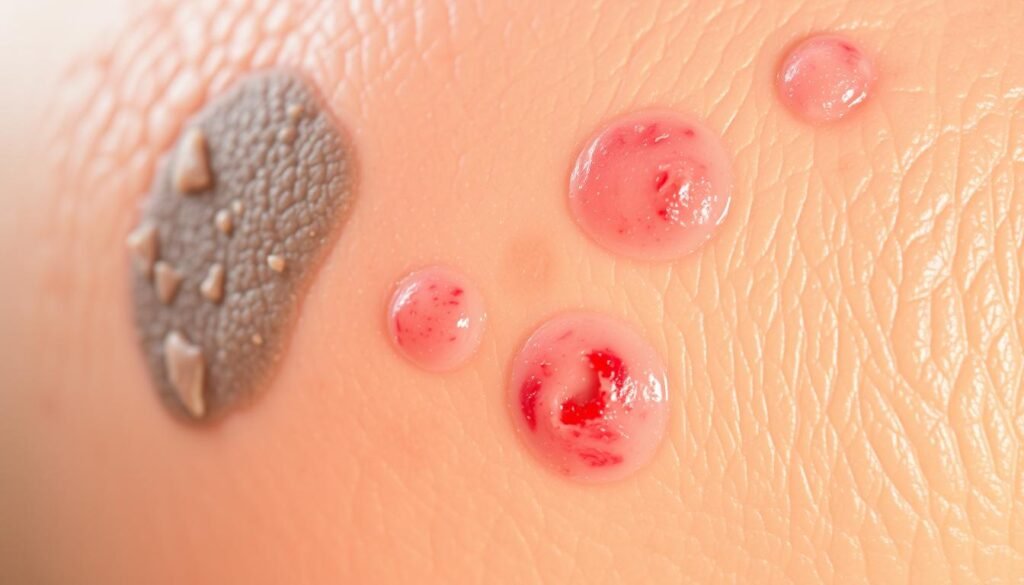Did you know most skin squamous cell carcinomas come from too much UV light? This light can be from the sun or tanning beds. In the United States, this skin cancer starts when skin’s flat cells grow too much. Though common and usually not deadly, squamous cell carcinoma (SCC) can become serious if ignored.
This guide will talk about signs and how to treat SCC. We will look at what causes it, who might get it, and how to prevent it. It helps people understand and manage this important health problem better.
Key Takeaways
- Squamous Cell Carcinoma is primarily caused by UV radiation exposure.
- This type of skin cancer can occur on both sun-exposed and non-exposed areas.
- Risk factors include fair skin, history of sunburns, and weakened immune systems.
- Early detection and treatment are crucial for a higher cure rate.
- Preventive measures include sun protection and regular skin checks.
Overview of Squamous Cell Carcinoma
Squamous Cell Carcinoma (SCC) is the second most common skin cancer. It starts in the squamous cells in the top layer of the skin. Often, it shows as a bump or sore, mainly on areas that get a lot of sun. Such as the face, neck, ears, lips, and hands. Every year, about 1.8 million cases of SCC are found in the U.S. This means around 205 cases every hour.
Over the last 30 years, the cases of Squamous Cell Carcinoma have grown by almost 200 percent. It shows why knowing and preventing this cancer is key. It’s more rare than basal cell carcinoma, which makes up about 80 percent of all skin cancers. Yet, SCC is still risky. It may start from actinic keratosis, which happens on skin damaged by the sun. If not treated early, SCC can spread fast.
SCC can be treated and is usually not deadly if caught early. Knowing about this skin cancer, including how to spot and treat it, is important. This knowledge helps manage risks and get better health results.
What Causes Squamous Cell Carcinoma?
The primary cause of Squamous Cell Carcinoma is too much UV radiation. This exposure leads to DNA damage in the skin. People who are in the sun a lot or use tanning beds are at higher risk. Tanning beds are especially risky, increasing the chances of getting SCC by 67% compared to those who don’t use them.
About 90% of nonmelanoma skin cancers are linked to the sun’s UV rays. This shows how important it is to protect yourself from the sun.
But UV radiation isn’t the only cause of Squamous Cell Carcinoma. Things like chemicals and other types of radiation also raise the risk. The human papillomavirus (HPV) can lead to more cases, especially in people with weak immune systems. For instance, organ transplant patients on certain meds are way more likely to get SCC.
Age and skin type also influence your SCC risk. It typically affects those over 50, but younger people aren’t safe if they spend lots of time in the sun or tanning. Certain genetic conditions make people more likely to get SCC, too. Untreated actinic keratosis lesions can become cancerous. Conditions like Bowen’s disease and leukoplakias might turn into severe cancer.
It’s important to know what causes Squamous Cell Carcinoma and how UV radiation damages DNA. This info helps in preventing the disease. Regular skin check-ups and protecting yourself from the sun are key. They help catch cancer early and reduce risks.
For more about skin cancer causes and types, check out this resource.
Risk Factors for Developing Squamous Cell Carcinoma
Some things increase the chance of getting Squamous Cell Carcinoma. UV rays from the sun play a big part. If you stay under the sun a lot, your skin damage adds up. This raises your risk. Tanning beds are also bad, especially for young people wanting to look tan.
People with fair skin, light eyes, and light hair face more risk. They have less melanin, which protects against sun. So, they burn easily. While anyone can get this cancer, it’s more common as you get older. This is because older people have been in the sun more over their lives.
Having a weaker immune system also ups your risk for skin cancers like this one. This can happen with HIV, leukemia, or if you had an organ transplant. If you’ve had skin cancer before, you’re more likely to get it again. Also, genetic disorders that make skin repairs hard can increase your risk.
Exposure to certain things in the environment, like arsenic or coal tar, adds to the danger. These are found in some jobs or even in well water. Radiation therapy boosts risk too, especially where the treatment is given. Knowing these risk factors helps with preventing and spotting Squamous Cell Carcinoma early.
Signs and Symptoms of Squamous Cell Carcinoma
It’s vital to know the signs of Squamous Cell Carcinoma (SCC) early on. Symptoms vary depending on your skin type. Knowing what to look for helps catch it early.
Common Visual Indicators
SCC has key visual signs that help spot it. Look out for:
- Firm, red nodules
- Flat lesions with a scaly or crusted surface
- Thick, rough patches that may bleed or crust over
- Open sores that do not heal
- Elevated growths with central depressions that can bleed
These signs often show up on sun-exposed skin like the face and neck. It’s smart to have regular skin checks.
Symptoms in Different Skin Types
SCC looks different in light versus dark skin. People with light skin often get red, scaly spots. But those with darker skin might see dark or violet bumps where the sun doesn’t hit much.
| Skin Type | Common Symptoms | Common Locations |
|---|---|---|
| Lighter Skin | Red, scaly lesions | Face, ears, scalp |
| Darker Skin | Dark or violet bumps | Areas not usually exposed to sunlight (palms, under nails) |
Knowing these specific symptoms is key in dealing with Squamous Cell Carcinoma. Always check your skin and use sun protection for prevention.

Diagnosis of Squamous Cell Carcinoma
It’s key to spot Squamous Cell Carcinoma (SCC) signs early for better treatment chances. Look out for sores that don’t go away or any new skin changes. Such as new growths. Seeing a doctor quickly when these signs appear is critical. It greatly improves the chances of effective treatment.
When to See a Doctor
If you spot strange changes on your skin, like a non-healing sore, get it checked. These could signal Squamous Cell Carcinoma. Seeing a doctor quickly is very important. People who have been in the sun a lot or have weak immune systems should be extra careful. They should see a doctor if they notice skin changes.
Diagnostic Procedures
To diagnose Squamous Cell Carcinoma, doctors start with a diagnostic procedure. A skin check by a dermatologist is usually the first step. Then, they may do a biopsy to confirm SCC. This can be a shave, punch, or excisional biopsy. The method chosen depends on where and how the lesion looks. If cancer spreading is a concern, a lymph node biopsy might be needed. This is done using fine needle aspiration.
Dermoscopy can help see the skin better by making it look ten times bigger. Reflectance confocal microscopy offers a view of skin cells. But most patients won’t need CT or MRI scans unless there’s a chance the cancer has spread.
| Diagnostic Procedure | Description |
|---|---|
| Visual Examination | Initial assessment carried out by a dermatologist to identify suspicious areas. |
| Skin Biopsy | Removal of a small skin sample to test for cancerous cells; types include shave, punch, and excisional methods. |
| Lymph Node Biopsy | Performed when cancer spread is suspected, using techniques such as fine needle aspiration. |
| Dermoscopy | An in vivo evaluation method allowing detailed inspection of skin lesions using magnification. |
| Reflectance Confocal Microscopy | Utilizes near-infrared laser light for a detailed cellular-level analysis of the skin. |
Knowing about diagnosis and treatment options is key to taking charge of your skin health.
Treatment Options for Squamous Cell Carcinoma
The way we treat Squamous Cell Carcinoma (SCC) depends a lot on the stage of the cancer. There are many treatments available. They are designed to effectively fight this specific cancer. Both non-surgical methods and surgery are key in fighting SCC.
Non-Surgical Treatments
Non-surgical treatments are a good choice for surface level SCC. They’re also used when surgery isn’t a good fit. Here are some common methods:
- Cryotherapy: This is great for treating surface SCCs. The process freezes the cancer cells. It’s especially helpful for patients who have certain health issues.
- Photodynamic therapy (PDT): This works well for SCCs on the face and scalp. It uses drugs sensitive to light and a light to kill cancer cells.
- Radiation therapy: This is used for SCCs that are hard to remove with surgery. It’s often the choice for older patients or those in poor health.
- Topical chemotherapy: This involves putting cancer-fighting drugs right on the skin lesions.
These non-surgical options can control the tumor well. They help avoid more invasive treatments.
Surgical Options
When we need to remove the SCC, surgery is the go-to method. There are several surgical treatments:
- Excisional surgery: This is a common method for small, early-stage SCCs. It removes the tumor and some healthy tissue around it.
- Mohs surgery: This has a very high success rate for first-time tumors. It’s great for SCCs that might come back.
- Curettage and electrodesiccation: Good for small, surface level, or slightly invasive SCCs.
- Laser surgery: Sometimes used for surface SCCs. But, it’s important to note it’s not FDA-approved for SCCs yet.
In advanced cases, treatments like immunotherapy or chemotherapy might be used. This is especially true if the SCC has spread. Patients should talk with their healthcare provider to choose the best treatment.

| Treatment Type | Best Use | Cure Rate/Effectiveness |
|---|---|---|
| Cryotherapy | Superficial SCC | Effective for early SCCs |
| Photodynamic Therapy | Superficial SCC on face/scalp | Effective for actinic keratoses |
| Excisional Surgery | Small, early SCC | High cure rate for localized SCC |
| Mohs Surgery | High-risk SCC | Up to 97% |
| Radiation Therapy | Large or hard-to-treat SCC | Used in elderly or poor health |
New advances in SCC treatment are exciting. They bring the promise of treatment plans made just for you.
For info on how genetics affects cancer risk, click here.
Prevention Strategies for Squamous Cell Carcinoma
Preventing Squamous Cell Carcinoma starts with less UV exposure and taking care of your skin. Knowing how to prevent it can help avoid this skin cancer type. By using these methods, you can boost your health and lower the chances of getting skin cancer.
The Importance of Sun Protection
Sun protection is key for keeping skin healthy. Most skin cancers, like Squamous Cell Carcinoma, come from the sun’s UV rays. To lower the risks, you should:
- Apply broad-spectrum sunscreen with an SPF of 30 or higher on all skin that the sun can see, even when it’s cloudy.
- Avoid being in the sun during peak hours, which are usually from 10 a.m. to 4 p.m.
- Wear clothes that cover your skin, hats with wide brims, and sunglasses that block UV rays.
- Stay away from tanning beds and sun lamps, as they give off dangerous UV light.
Kids who play outside a lot need extra care to stay protected from the sun. They can get sunburned easily, which can harm their skin over time.
Regular Skin Checks
Checking your skin often is important to spot any early signs of cancer. You can check your skin at home or see a dermatologist. Make sure to:
- Look over your skin every month for new spots or changes in moles.
- Talk to doctors if you notice anything weird on your skin.
- Encourage family to get their skin checked regularly for safer health.
Finding Squamous Cell Carcinoma early means a better chance of treating it well. Focus on prevention and checking your skin often for the best defense against skin cancer.
Complications and Prognosis
If left untreated, Squamous Cell Carcinoma (SCC) can lead to severe health problems. It may spread to nearby tissues and organs. This can cause metastasis to lymph nodes or other critical areas, which is life-threatening.
Potential Risks of Untreated Squamous Cell Carcinoma
Several factors affect the outlook for SCC patients. Those with a history of SCC or a weak immune system face higher risks. Small lesions have a better outlook, but big or aggressive tumors are more dangerous. Complications can include serious tissue damage and loss of function, especially if the cancer is in a crucial area. Catching the cancer early greatly improves chances of effective treatment.
Follow-up appointments and a mix of treatments can help patients live longer. This can include surgery and radiation for cancer that has spread. People at risk should get regular skin checks to catch any changes early. Moffitt Cancer Center offers personalized treatment plans that can make a big difference. Integrating immunotherapy with standard treatments is showing promise, offering hope for better outcomes.

Living with Squamous Cell Carcinoma
After being diagnosed with squamous cell carcinoma, life changes a lot. People need ways to handle the emotional and physical effects. They see their doctors often, every 3 to 6 months at first. This helps catch any signs the cancer might be returning. Knowing about your treatment and its side effects is key in making a health plan.
Eating right and staying at a healthy weight helps with healing. It could also lower the chance of the cancer coming back. Staying active is important for your health when living with this cancer. Support from loved ones and professionals is also crucial in dealing with this challenge.
Cancer support groups offer useful advice and connect you with others. Talking about your feelings helps build strength during hard times. Here are some main ways to cope:
| Coping Strategies | Description |
|---|---|
| Education | Understanding the condition and treatment options to empower personal health choices. |
| Healthy Lifestyle | Maintaining a balanced diet and engaging in physical activity for overall well-being. |
| Emotional Support | Accessing support groups and mental health professionals to manage the emotional aspects of cancer. |
| Regular Check-ups | Staying on schedule for follow-up appointments for early detection of any changes. |
| Sun Protection | Wearing broad-spectrum SPF 30 sunscreen daily to minimize UV exposure and reduce recurrence risk. |
Dealing with squamous cell carcinoma means taking care of your health and seeking support. Learning and getting help from others makes managing this journey easier.
Conclusion
Squamous Cell Carcinoma (SCC) is a big health problem in the U.S. It’s the second most common skin cancer. Each year, over one million people are diagnosed. It mainly affects people over 50. Yet, everyone should know its signs, symptoms, and treatments. Knowing about Squamous Cell Carcinoma helps catch it early and treat it quickly.
There are many ways to treat SCC. Surgery is often used. Sometimes, doctors also use chemotherapy. But these treatments can have side effects. This shows why it’s important to know how to prevent and manage SCC. Talking regularly with doctors can help find the best treatment. It also offers support to those dealing with SCC.
Teaching patients and taking good care of our health are key to fighting SCC. It’s very important to work on stopping it before it starts. We also need to understand how to treat it. This way, we can lessen the impact of Squamous Cell Carcinoma on people’s lives and on communities.